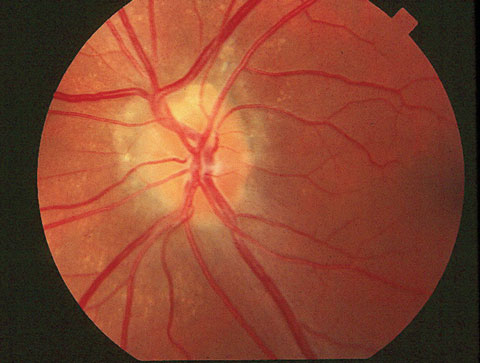 |
|
In patients from this study cohort diagnosed with normal-tension glaucoma, the 6.0% with optic disc drusen also had a lower cup/disc ratio and less prominent cup depth. Photo: Joseph Sowka, OD. Click image to enlarge. |
In patients diagnosed with normal-tension glaucoma (NTG), the potential presence of optic disc drusen (ODD) is often overlooked, especially in cases where ODD is buried in the deep layers of the optic nerve head. A previous study found that ODD presents in an estimated 0.2% to 0.3% of the general population, while autopsy studies have found its prevalence to be 1.8% to 2.0% (indicating a greater occurrence of buried, non-visible ODD). Recently, a team of researchers observed that this percentage appears to be even higher in normotensive glaucoma patients, detecting ODD in approximately 6.0% of NTG patients in their study. The majority of these patients had nonvisible ODD, as well as a low cup/disc ratio.
The prospective cross-sectional study included 98 patients with an NTG diagnosis from two glaucoma units (61 females and 37 males; mean age: 71.5). Of 195 total eyes, ODD was detected in seven eyes (3.6%) of six patients (6.1%), including four females and two males.
“ODD were bilateral and ophthalmoscopically visible in one male, while unilateral and buried in the other five patients (four females and one male),” the researchers wrote in their study. “Four of these five patients presented only a single relatively large ODD (245μm to 452μm in diameter),” which they noted was found in the nasal section of the optic disc. The patient with bilateral, visible ODD also had deep ODD in the optic nerve head.
The researchers noted that they found no difference in age, intraocular pressure or retinal nerve fiber layer thickness between eyes with and without ODD. Some of the visual field defects observed in eyes with ODD included constriction of the visual field, arcuate scotomas, nasal steps and paracentral defects.
Eyes with ODD also had a lower cup/disc ratio than those without ODD (0.44 vs. 0.81, respectively). Additionally, eyes with ODD had a less prominent cup depth (236.6μm vs. 437.8μm, respectively). When the team evaluated scleral canal diameter in patients with and without ODD, they observed no significant difference between groups.
These findings demonstrate that the “prevalence of ODD in patients diagnosed with NTG is substantially higher than in the background population,” the researchers concluded in their paper. They also noted that a low cup/disc ratio correlates with the presence of visible and/or nonvisible ODD.
Considering this new data, the team “recommend[s] examining the deep layers of the optic nerve head in NTG patients with a cup/disc ratio lower than 0.5 to avoid misdiagnosing ODD as NTG.”
Ahmadi H, Fotesko K, Shakoor Ba-Ali S, et al. Optic disc drusen in patients diagnosed with normal tension glaucoma. Acta Ophthalmol. November 14, 2022. [Epub ahead of print]. |

